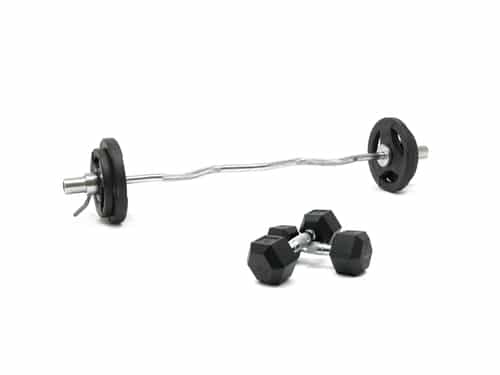
Barbells versus Dumbbells: The Benefits of Dumbbells over Barbells
Dumbbells are usually less intimidating for beginners who are just starting to strength train. They’re easier to handle, and they allow you to learn good form before challenging yourself with barbells. With dumbbells, you can also work one side of your body independently of the other. This lets you focus on each side individually, making it easier to correct muscle imbalances.
Unlike barbells, dumbbells also recruit the smaller stabilizer muscles. This means you can work more muscle groups at the same time. There’s also the issue of safety. When you’re using dumbbells, and your muscles have fatigued to the point you can’t complete another rep, you can easily put the weight down. When you’re working with barbells, you can’t safely drop the weight, so the risk of injury is higher.
Finally, you can move dumbbells in more than one plane of motion, which gives you the ability to do more exercises. You can also use dumbbells in place of almost any barbell exercise while the opposite is not true.
Barbells versus Dumbbells: The Advantages of Training with Barbells
When you train with barbells, you can lift heavier with better control. Barbells work well for lower body exercises like squats and stiff-leg deadlifts when you want to use a heavier weight. Barbells may also have some advantage when it comes to building strength. According to research published by the National Strength and Conditioning Association, barbells provide more of a training stimulus than dumbbells or kettlebells. This isn’t surprising since you can lift heavier with barbells than you can with dumbbells or kettlebells. It’s also easier to pick up and position a barbell than it is to lift and position two heavy dumbbells.
Dumbbells versus Barbells: Which Should You Choose?
When you’re first starting out, dumbbells are safer and easier to manage, but as you progress in your strength training work, adding barbell exercises is a way to challenge your muscles in a new way – and variety is the key to avoiding a strength plateau.
Barbells are particularly effective for squats and compound exercises that focus on the lower body since you can go heavier. Dumbbells are superior for isolating smaller stabilizer muscles and correcting muscle imbalances since you can focus on a single side. You can also do a wider range of exercises with dumbbells since you can move them through more than one plane.
The Bottom Line?
Dumbbells and barbells each have their advantages when it comes to building strength and lean body mass. When starting out, use dumbbells. Once you’re comfortable with them, transition over to barbells for lower body exercises like squats and deadlifts when you want to lift heavier. Barbells have a slight advantage when it comes to building strength, but with dumbbells, you can work the stabilizer muscles too and get a more balanced workout. The good news? You don’t have to choose.
References:
National Strength and Conditioning Association”; Barbells, Dumbbells, and Kettlebells; Loren Chiu.
Related Articles By Cathe:
Why You Should Use Both Barbells and Dumbbells
Are Dumbbells an Effective Substitute When You Don’t Have Barbells?

